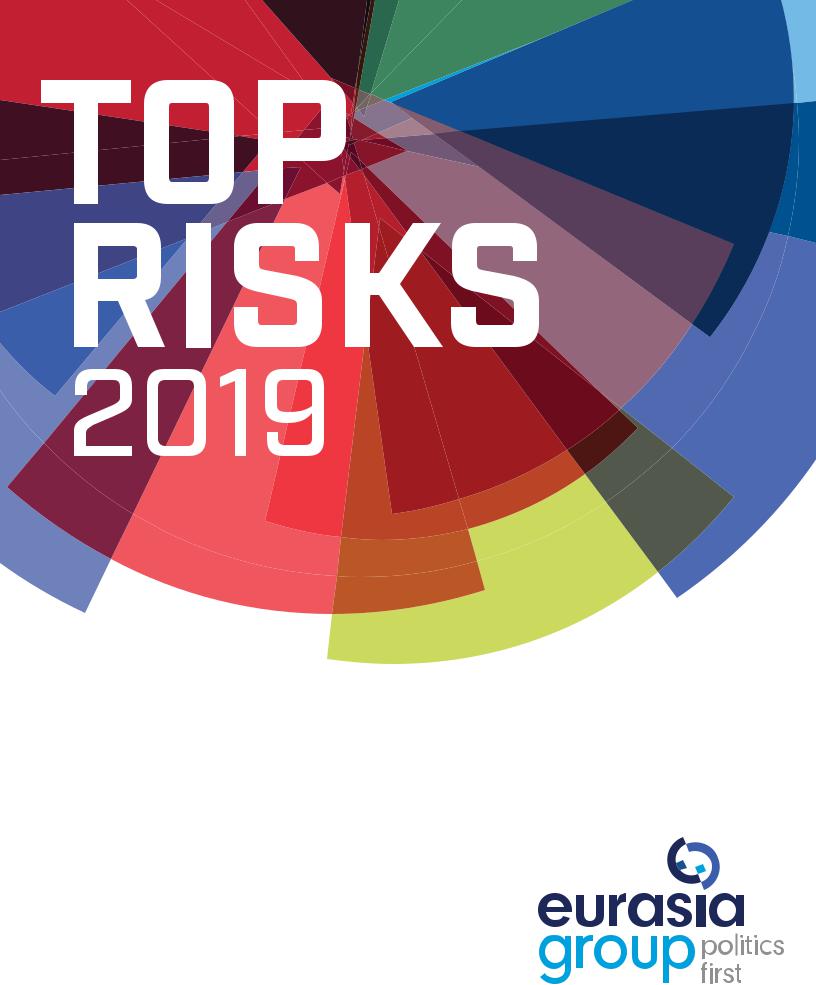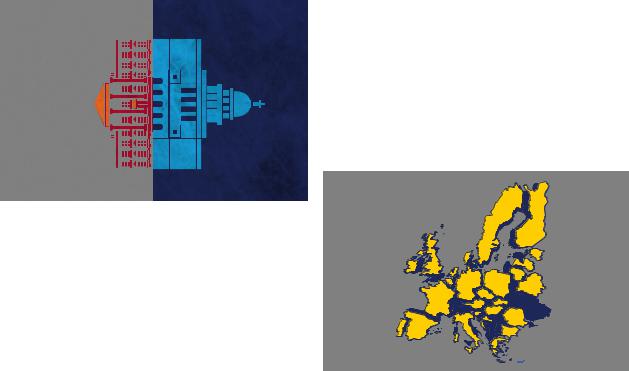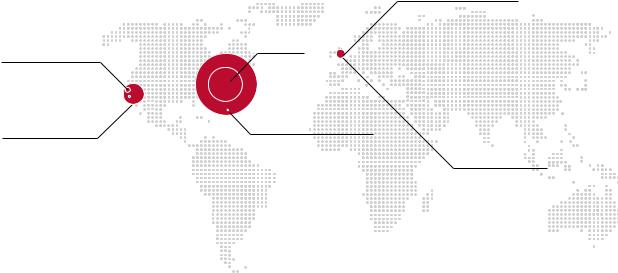
Top_Risks_2019_Report_watermark
.pdf
vk.com/id446425943
IAN BREMMER, President
CLIFF KUPCHAN, Chairman
1 Bad seeds
2US-China
3Cyber gloves off
4European populism
5The US at home
6Innovation winter
7Coalition of the unwilling
8Mexico
9Ukraine
10 Nigeria
* Brexit
- Red herrings

vk.com/id446425943 
Overview
IAN BREMMER, President
CLIFF KUPCHAN, Chairman
The geopolitical environment is the most dangerous it’s been in decades ... and at a moment when the global economy is faring well. Markets are increasingly volatile but resilient, taking hits but mostly bouncing back. What’s wrong with this picture?
Nothing … yet. Geopolitical cycles are slow-moving. It takes a long time to build a geopolitical order; governments change course through the workings of complex institutions, coalition politics, election cycles, and checks and balances. Multilateral institutions take decades to build, and they gain momentum slowly. Norms and values need to develop, to become accepted, and to shape institutions and societies over time. Once in place, they’re sticky. And so, barring bad luck (read: a sudden unforeseen crisis), it takes years, even decades to knock down a geopolitical order. That process of erosion is underway around the world today.
Sure, 2019 could turn out to be the year the world falls apart. Tail risks created by bad actors in‰icting damage that then create an escalatory cycle are higher than they’ve been at any point since we launched Eurasia Group in 1998. A Russian cyberattack gets out of control. Iran and Saudi Arabia (or Israel) trigger a Middle East war. The Chinese and Americans get into a trade war that causes a deep recession, they blame one another, and retaliation spills into the kinetic space. There are other risks of similar scale. But for now, all of these remain low-likelihood events.
More likely, and despite increasingly worrisome headlines, 2019 is poised to be a reasonably good year. Even, dare we say it, not a particularly politically risky year. But we’re setting ourselves up for trouble down the road. Big trouble. And that’s our top risk.
Top Risks 2019 |
eurasia group | 2 |

vk.com/id446425943
 Bad seeds
Bad seeds
The geopolitical dangers taking shape around the world will bear fruit in the years to come. This is the greatest impact of the G-Zero: The world’s decision-makers are so consumed with addressing (or failing to address) the daily crises that arise from a world without leadership that they’re allowing a broad array of future risks to germinate, with serious consequences for our collective midterm future.
The overwhelming majority of geopolitical dynamics that matter are now headed in the wrong direction
Consider the trajectories of all the current geopolitical dynamics that matter. Start with the big ones. The strength of political institutions in the US and other advanced industrial economies. The transatlantic relationship. US-China. The state of the EU. NATO. The G20. The G7. The WTO. Russia and the Kremlin. Russia and its neighbors. Regional power politics in the Middle East. Or in Asia, for that matter.
Every single one of these is trending negatively. Every single one. And most in a way that hasn’t been in evidence since World War II. Indeed, the overwhelming majority of geopolitical developments that matter, the wide array of issues that we follow at Eurasia Group—more than 90% of them—are now headed in the wrong direction.
Top Risks 2019 |
eurasia group | 3 |

vk.com/id446425943
These relationships and institutions won’t collapse tomorrow, but the risks plaguing them are landmines. That’s especially important because they’re all pieces of the international architecture, some of them foundational. Eventually, people are going to get hurt. Think climate change, but in the geopolitical sphere.
Let’s take a closer look at several of these bad seeds.
An overwhelming majority of Americans don’t trust Congress. The political parties have grown further apart, and the political center has disappeared—near- ly half of all Democrats and Republicans now report they “hate” the other side. Social media has further undermined people’s trust in what’s true, and there’s no clear message from government on how large information technology companies should be regulated.
Meanwhile, Trump has weaponized the divisions between his supporters and those who oppose him, transforming governing institutions into political battlegrounds, weakening the long-term functionality of a representative democracy, and persuading a larger percentage of citizens that the system is “rigged” against them. If Trump is defeated in 2020, the trend will slow. But American liberal democracy and accompanying values aren’t what they were. No one can put humpty dumpty back together again.
a – US political institutions
It’s not urgent. President Donald Trump has been notably constrained by US institutions—the judiciary slapping limits on his immigration policies, bureaucrats slow-rolling regulatory changes, and Congress focused on incremental approaches to change rather than passing legislation that generates sudden, dramatic upheaval. Not to mention preventing Trump from taking any measures to impede special counsel Robert Mueller’s investigation. Indeed, a›er two years of the Trump administration, the most important domestic takeaways are how resilient US political institutions have proven and how eœectively they’ve limited Trump’s intended actions.
But damage is being done to the legitimacy of democratic institutions in the world’s largest economy. The list of examples is long. Trump publicly contradicts high-conždence estimates of US intelligence agencies. He claims choices made by lead actors at the Justice Department and the FBI are politically motivated. He insists the judiciary is biased against him and that journalists are enemies of the people.
b – Europe
It’s not urgent. The ongoing Brexit debacle has made clear that nobody benežts from an exit. That, in turn, has forced euroskeptic parties like the National Rally (France’s rebranded National Front) and the League (Italy’s former Northern League; why do these far-right parties keep changing their names?) to shi› gears.
But nearly every current trend in Europe weakens the broader European convergence project. Obviously, without the Brits, Europe isn’t what it was. With Chancellor Angela Merkel in succession mode, neither is Germany. With President Emmanuel Macron at 23%
Top Risks 2019 |
eurasia group | 4 |

vk.com/id446425943
approval, facing a state of national emergency and his domestic and European-integrationist reforms a dead letter, there’s a limit to what can be expected
from France. Now consider the governments—in Italy and much of eastern Europe—controlled by those who want to assert more national sovereignty to claw back power from Brussels. Add a more divided European parliament a›er May elections (please see Top Risk #4), and Europe is headed toward (at best) a more fragmented future or (at worst) a long, slow unwind.
Presuming no immediate unforeseen emergencies, European governments can handle shocks more easily when there’s decent economic growth and money to spend. But when belts must be tightened, žghts become crises. The reason many in the UK voted to leave the EU is that they recognized it wasn’t žt for purpose over the long term. On that count, they look to be right.
ability to pursue its interests. That means alliances are eroding and will continue to do so. Transatlantic relations are in the roughest shape given challenges on both sides of the Atlantic; in particular, US-Ger- man and US-French relations are deteriorating. That undercuts NATO and the broader international order. Trump’s skeptical view of alliances could well spread next to bases and activity in the Middle East.
Asia is least aœected. Both Trump and the political establishment remain committed to the region, in large part because of China’s rise. The US-Japan alliance remains strong. But even here, watch South Korea, where Trump would prefer to reduce the US military presence, while continuing to create uncertainty on trade. Trump’s doubts about alliances create opportunities for Chinese leader Xi Jinping, Russian President Vladimir Putin, populists in Europe, and others happy to exploit frustration with Washington. This trend will slow if Trump fails to win a second term as president, but the move toward a more modest conception of American power and a weaker set of alliances began well before Trump arrived.
c – The system of global alliances
It’s not urgent. The US remains a critical ally for most of the world’s developed nations. And it isn’t going home this year.
But US alliances everywhere are weakening. Trump has said it’s not America’s job to police the world and other nations must pay for their own security. Trump’s views on trade are decidedly unilateral. And the US has stepped well back from promoting common values; indeed, it’s hard for the US to agree what American values are. On all three fronts, the Trump administration sees alliances as corsets that restrict the US’s
d – Populism/nationalism
It’s not urgent. Aggrieved and disenfranchised populations remain minorities in most developed countries, with less ability to force change than the elites in power. The political “swamp” resists being drained, and most governments continue to allocate resources much as they have over the past several decades.
Top Risks 2019 |
eurasia group | 5 |
vk.com/id446425943
But these trends are becoming more toxic, especially given the growing disintermediation of labor from capital. The “fourth industrial revolution” is appropriately named for its benežciaries—it promises more growth and more e«ciency. But for those whose jobs are lost to automation and don’t have the education and training to žnd new employment that demands new skill sets, it’s a post-industrial revolution. They’ll end up part of an expanding group who believe their political systems can’t meet their needs.
These polarizing trends now being politically exploited across the advanced industrial world and in pockets of wealthier emerging markets are likely to intensify and spread over the coming decade, weakening governments and delegitimizing political leaders as a consequence. Along with the US-China con‰ict, this is the risk that will be most frighteningly intensižed by the next global economic downturn. We don’t want a repeat of the 1930s.
***
There are others we could add to this list. Xi’s success in consolidating so much power in China is a “bad seed” because it makes decision-making in (what will soon be) the world’s largest economy less predictable and a smooth future leadership transition much more challenging. The žght among regional powers for dominance in the Middle East is set to pose a much larger challenge over time, especially given the reduced value of their oil exports for the global economy. Decentralization of control over dangerous technologies—partic- ularly malware, drones, and biological weaponry—is another. Add the continued inadequate and poorly coordinated political response to climate change. Those are far more bad seeds than we’ve ever seen geopolitically. We’re not looking forward to the harvest.
Top Risks 2019 |
eurasia group | 6 |

vk.com/id446425943
 US-China
US-China
The truce that Trump and Xi struck at the G20 meeting in Buenos Aires last month put a temporary halt to the path of tari‡ escalation the US and China had embarked on. Yet we remain concerned about the world’s most important bilateral relationship. We’re not confident the trade and economic disagreements will be resolved anytime soon. And something more fundamental has broken in the relationship between Washington and Beijing that can’t be put back together, regardless of what happens to their economic ties.
On trade, it remains to be seen whether last month’s truce can be turned into a longer-term peace. We’re skeptical. The o«cial timeline for negotiations is short (though Trump is likely to extend it). The issue to be resolved is the fundamental nature of China’s economic system—something Beijing is unlikely to compromise on. That makes a comprehensive deal hard to reach, an eœort to “paper over” differences hard to sustain.
Further, a deal on tariœs wouldn’t end economic friction between the US and China. US economic grievances are bipartisan and therefore harder to resolve regardless of next steps. US and Chinese supply chains and technology cooperation will continue to fragment even if tariœ threats recede.
At issue is the fundamental nature of China’s economic system— something it
is unlikely to compromise on
Top Risks 2019 |
eurasia group | 7 |

vk.com/id446425943
The Trump administration is determined to force US companies to reduce their reliance on inputs from China and to limit the transfer of intellectual property, particularly in high-tech sectors and those related to national security. The US will continue to use non-tar- iœ barriers as a key tool in this push, including investment restrictions, export controls, žnancial sanctions, and criminal indictments. China will reciprocate with its own non-tariœ measures—from its cybersecurity laws to antitrust decisions. Moves on both sides will disrupt žrms and broader industries, increasing costs and decreasing collaboration.
Perhaps more importantly, even if the US and China can resolve their trade tensions, and even if they can keep the economic competition civil, the limited trust that underpins the US-China relationship appears to be gone.
Beijing and Washington have always viewed one another with suspicion. But until a few months ago, both shared a common understanding that it was in both their interests to at least try to keep their relationship as amicable as possible for as long as
possible. That’s changed, especially in Washington. The US political establishment believes engagement with Beijing is no longer working, and it’s embracing an openly confrontational approach. Beijing is less ready to take the gloves oœ—partly because it feels China is not ready to challenge the US—but rising nationalist sentiment makes it unlikely that Beijing will ignore US provocations. Structural competition and dangers will shape the relationship—in the technology, economic, and security arenas. Tensions will grow regardless of what happens on the trade issues currently making headlines.
This new competition means areas of discord will become more escalatory in 2019. Neither side wants a direct military confrontation, but there is a greater chance that an accident—such as a collision in the South China Sea—becomes a full-blown foreign-policy crisis. The two countries in the past have successfully navigated several such near-crises, including the collision between a US spy plane and a Chinese žghter in 2001. Doing so again would be much harder in today’s climate.
The many layers of US-China tensions
|
|
|
Capitalism with Chinese characteristics |
||||||||
|
Global governance |
Belt and Road |
Rules-based system |
||||||||
|
|
Ideology |
Indo-Pacific strategy |
||||||||
|
|
Quantum computing |
Post-war order |
||||||||
Tech |
|
|
|
5G |
|||||||
Digital silk road |
|
|
|
|
|
|
|
||||
|
|
|
|
|
|
Semiconductors |
|||||
|
Great |
|
|
|
|
|
|
|
|||
|
|
ICT supply chains |
|
|
|
||||||
|
Firewall |
|
|
|
|
||||||
|
|
|
|
|
|||||||
|
|
Artificial intelligence/automation |
|
|
Nine-dash line |
||||||
|
|
|
|
|
|
|
|
|
|
|
|
|
Alliances |
North Korea |
Freedom of navigation operations |
||||||||
|
Trade deficit |
South China Sea |
|||||||||
|
|
|
|||||||||
|
|
Joint venture |
Subsidies |
Taiwan |
|||||||
|
|
requirements |
Market access |
|
|
|
|||||
Trade |
|
|
CFIUS |
IP theft |
|
|
|
|
|
|
|
|
|
|
|
|
|
|
|
|
|||
|
|
|
|
|
|
|
|
|
|||
|
|
|
|
|
|
||||||
|
|
|
|
Tariffs |
|
|
|
||||
Source: Eurasia Group
Global leadership
Security
Top Risks 2019 |
eurasia group | 8 |

vk.com/id446425943
|
|
|
|
|
|
|
|
|
|
|
|
|
|
|
|
|
|
|
|
|
|
|
|
|
|
|
|
|
|
|
|
|
|
|
|
|
|
|
|
|
|
|
|
|
|
|
|
|
|
|
|
|
|
|
|
|
|
|
|
|
|
|
|
|
|
|
|
|
|
|
|
|
|
|
|
|
|
|
|
|
|
|
|
|
|
|
|
|
|
|
|
|
|
|
|
|
|
|
|
|
|
|
|
|
|
|
|
|
|
|
|
|
|
|
|
|
|
|
|
|
|
|
|
|
|
|
|
|
|
|
|
|
FANCY BEAR |
|
GOTHIC PANDA |
|
|
|
REAPER |
|||
|
|
|
|
|
|
|
|
|
|
|
 Cyber gloves off
Cyber gloves off
This year marks a decade since the US and Israel destroyed portions of Iran’s covert nuclear weapons program using a computer worm known as Stuxnet, ushering in the modern era of cyber conflict. Ten years on, hackers have grown more sophisticated, societies have become heavily dependent on digital services, and e‡orts to agree on basic rules of the road for cyber conflict have gone nowhere. It’s a mess.
For the first time, the US will attempt to establish deterrence by projecting its cyber power in more assertive ways
Cyber deterrence is hard. The source of an attack and lines between state and nonstate actors are blurred in cyberspace. That makes it di«cult to be sure whom to retaliate against, and attackers know that. Also, there is still a lack of clear red lines in many areas, meaning attackers can o›en get away with their misdeeds if they avoid clear no-gos (such as critical infrastructure). Finally, cyber weapons become obsolete fast, and access to targets comes and goes. It’s tempting to use a capability when you can, making the idea of Cold War-style peaceful stockpiling of weaponry less likely.
Top Risks 2019 |
eurasia group | 9 |

vk.com/id446425943
Major recent data breaches |
|
|
BRITISH |
|
AIRWAYS 380K |
|
||||||
Number of users a ected |
|
|
|
|
|
|
TICKETMASTER UK 400K |
|||||
|
|
|
|
|
|
|
|
|
||||
|
|
|
UNDER ARMOUR |
|
|
|
||||||
FACEBOOK 3 million |
150 million |
|
|
|
||||||||
|
||||||||||||
|
|
|
|
|
|
|
|
|
|
|||
GOOGLE+ 500K |
|
|
|
|
|
|
|
|
|
|
||
|
|
|
|
MARRIOTT 500 million |
|
|
|
|
|
|||
|
|
|
|
|
|
|
|
|
||||
|
|
|
|
|
|
|
|
|
|
|
||
|
|
|
|
|
|
|
|
|
||||
UBER 57 million |
|
FEDEX BONGO 119K |
|
|
||||||||
|
|
|
|
|
|
|
|
|
|
|
|
|
|
|
|
|
|
|
|
|
|
|
|
DIXON CARPHONE |
|
|
|
|
|
|
|
|
|
|
|
|
10 million |
|
Source: CFR, Eurasia Group
So, if cyber deterrence has never come close to actually working, what’s new?
This year is a turning point. For the žrst time, the US will be undertaking a serious eœort to establish real deterrence by projecting its cyber power in much more assertive ways. Not only will this show of strength fail to create an eœective system of global deterrence, but it could backžre.
The US is changing its tone—and the doctrine of action and reaction—to become far more aggressive in the cyber world than it’s been in the past. A›er taking a cautious approach while former president Barack Obama was in o«ce, the US is now leaning heavily toward greater oœensive action in cyberspace, including by freeing the Department of Defense’s Cyber Command to unleash preemptive strikes. It’s even considering giving private-sector actors leeway to “hack back” when attacked.
In an ideal world, this show of teeth would lead foreign actors to keep their arsenals in check and create a new security equilibrium in which perceptions of US cyber dominance would discourage attacks. That’s not going to work—for two reasons.
First, like traditional deterrence, cyber deterrence works best against states. But many of the world’s most
destructive cyber actors are non-state actors who have less to lose from taking their chances on oœense. We’re particularly worried that the stolen National Security Agency tools that powered the 2017 NotPetya attacks are being updated for current so›ware systems and have been incorporated into sophisticated cyber operations. Non-state actors’ temptation to use them against critical infrastructure or corporate networks before systems are upgraded will increase in 2019.
Second, even governments won’t back down in reaction to Trump’s assertive cyber policy. In the US-Russia rivalry, it’s unclear which nation controls escalation dominance—the ability of one side to dominate a conflict as it grows more serious—and whether classic deterrence would work. For weaker states such as Iran or North Korea, there’s also an asymmetry of power in the use of cyber weapons that makes them too tempting not to use. Several of the world’s most aggressive cyber powers have little to lose in the event of retaliation, given their low level of connectedness (think North Korea). And for China, the stakes are too high to allow the US sole use of a weapon that works. All of this leads to a scary prospect: The Trump administration thinks it’s strengthening deterrence (and therefore peace) by deploying its arsenal, but the odds are greater that this show of force leads nations to “see and raise” the US’s bet.
Top Risks 2019 |
eurasia group | 10 |
